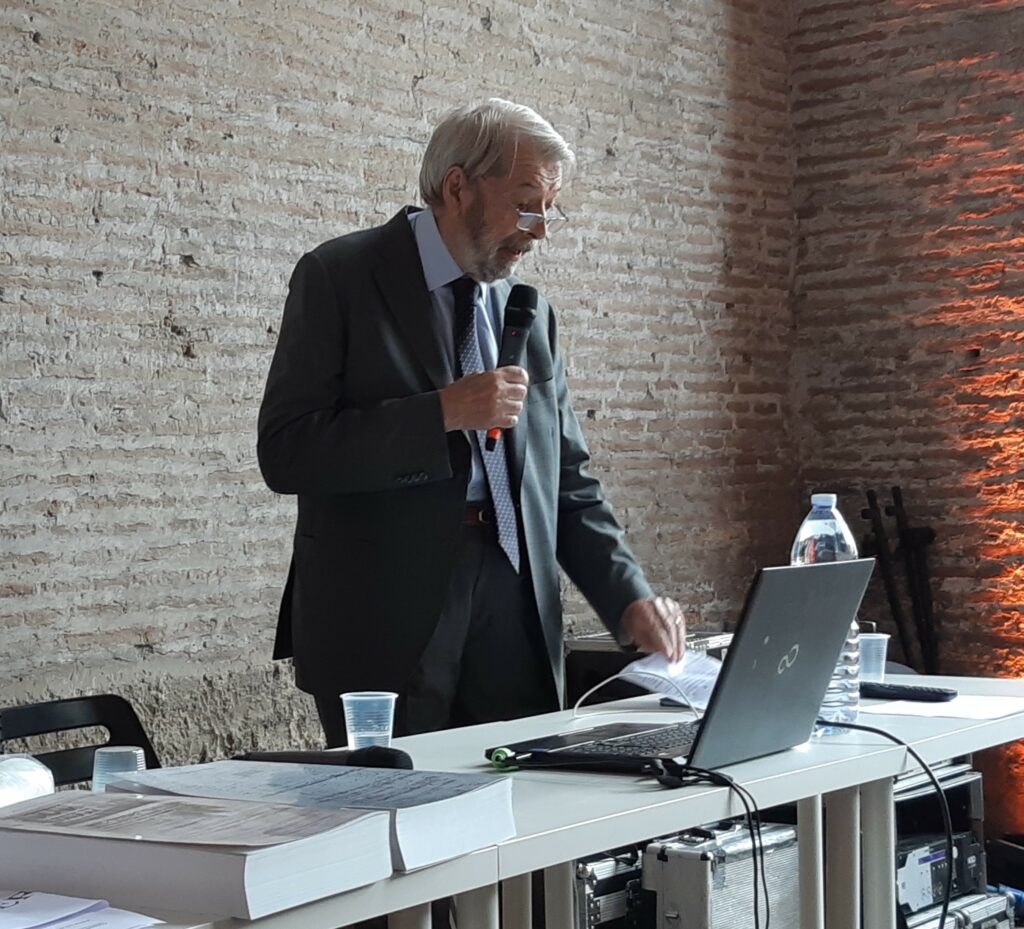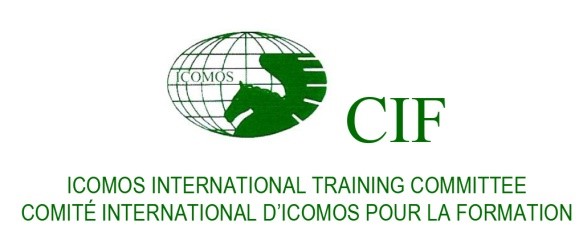In Memoriam: Professor GIOVANNI CARBONARA, Architect, Professor Emeritus of Architectural Conservation at Sapienza University of Rome, an International Reference in Architectural Conservation Education, Scholarship and Practice and a Role Model
ICOMOS CIF expresses the deepest condolences for the passing of Professor Carbonara to his family, friends and colleagues

Professor Giovanni Carbonara (b. 27th November 1942), an international reference in architectural conservation (Restauro) passed away on 1st February 2023. He was an Architect and Professor Emeritus of Architectural Conservation at the Sapienza University of Rome, where he was the Director and Professor at the Postgraduate Specialization School in Architectural Conservation. He not only educated, trained and mentored hundreds of conservation architects who specialized at the School, but also thousands of graduating students of architecture, as architectural conservation (Restauro) is part of the architecture degree curriculum in Italy. He firmly promoted the fact that, in order to be a good specialist conservation architect, one has to be first a good architect, He also highlighted that any architectural conservation project should have clear leadership by the competent professional. In his own and recent words:
“The disquisition on where the architectural conservation ends and where the architectural design or composition begins, does not excite me also because, conceptually, there is no clear border but there can be a thousand nuances.”
“The architectural conservation project must be directed by the architect; one cannot think that it is the result of a simple sum of competences and skills”
Professor Giovanni Carbonara, 2022
Professor Carbonara received multiples awards and distinctions, between them, in 2020, the Prix de l’Académie d’Architecture in France, the ICCROM Award (UNESCO) for contribution to the Preservation and Conservation of Cultural Heritage in 2017 and the Gold Medal of the Meritorious of Culture and Art by the President of the Republic in Italy in 2008.
He actively contributed to architectural conservation and design projects as consultant and advisor as well as to national and international scientific committees. Since his seminal publication in 1976 ‘La reintegrazione dell’immagine. Problemi di restauro dei monumenti’, he extensively published on history of architecture, theory, ethics and practice of architectural conservation. Professor Carbonara also had a very intense editorial role. He founded and directed four editorial collections of exceptional quality:
- History of building techniques (published by ‘L’Erma’ di Bretschneider, Rome)
- Architectural conservation (published by Liguori, Neaples)
- History of architecture and of conservation (published by Aracne, Rome)
- Techniques of conservation (published by Carsa, Pescara).
His outstanding scholarship, dedication to his students and his personal qualities made of him a role model for generations of students; he became for many of them a mentor for life. This text and the references below intend to commemorate him and to contribute to disseminate all his knowledge, scientific contribution and approach. Professor Carbonara was – and he will continue to be -, a great example of good practice for education and training, academic rigour and consistency between theory and practice. He actively contributed recently to the ICOMOS CIF 2022 Symposium and to the ICOMOS CIF Decalogue for Education in Architectural Conservation, which we are dedicating to him.
Cristina González-Longo, ICOMOS CIF President, Professor Carbonara’s student and mentee
The following list of recent and key activities as well and publications were selected by Professor Carbonara in 2021.
Advisory Roles Held
President of the Technical-Scientific Committee for Architectural Heritage and Landscape Department of the Ministry of Cultural Heritage and Activities (2007-2018).
President of the Technical-Scientific Committee for the “Ripartire da Collemaggio” project (MiBAC, Segretariato Generale e Direzione Regionale B.C.P. dell’Abruzzo; Comune dell’Aquila; Eni Servizi) (2012-16). The project won the Conservation European Heritage Award/Europa Nostra Award 2020 and the Grand Prix Europeo – EU (2020).
Member of the Supreme Council for Architectural Heritage and Landscape (2007-2018).
Member of the National Committee for the Safeguarding Cultural Heritage from Earthquake Risks, established by the Ministry of Cultural Heritage and Activities (since 2008).
Member of the Italian-Spanish Commission of Experts appointed by the Royal Academy of Spain in Rome for the restoration of the Cloister of the Tempietto di Bramante in San Pietro in Montorio, Rome (since 2018).
Member of the Scientific Board of the Supreme Conservation and Restoration Institution (ISCR), Rome, Ministry for Cultural Heritage and Activities (2009-2018).
Member of international “Comité des Sages” for writing the Charter for the restoration of monuments of Byzantine culture, European Center for Byzantine and post-Byzantine Monuments, Tessaloniki, Greece (2013-2018).
Member of the Inter-ministerial Working Group for the updating of the Guidelines for the evaluation and reduction of the seismic risk of cultural heritage. Coordinator for the Cultural Heritage sector (2017-18)
Member of the Steering Committee for the restoration of the Basilica of San Benedetto in Norcia (MiBACT, DM 19.4.2018 n.209) (2018).
Member of the Honorary Committee of the 4th International Conference Byzantine Monuments and World Heritage IV: Charter for the Protection of Byzantine Monuments, (Thessaloniki, 30 November – 2 December 2018).
Member of the Advisory Scientific Committee for the Restoration of the Pauline Chapel of the Vatican Apostolic Palace, established by the Governorate of the Vatican City State (2004-2009).
Projects involved as Scientific Consultant
Bassano del Grappa, Ponte degli Alpini (XVI-XX sec.) (Comune di Bassano, with Claudio Modena);
Ferrara, Cathedral (XII-XVIII sec.);
Gerusalemme, Dar Al complex;
Masterplan for the hstoric center of Khorfakkan e Sharjah, E.A.U., Dubai;
Teatro Valle, Rome (with ing. Nicola Berlucchi, Studio Croci);
Verona, roman Arena (I century A.C.)
Assisi, Basilica of S. Francesco (XIII-XIV centuries);
Bassano del Grappa, Ponte degli Alpini (arch. Andrea Palladio, XVI-XIX centuries);
Betlemme (Israel, Palestinian Athority), Nativity Church, with C.Alessandri (2010);
Ferrara, Cathedral (XII-XIV centuries);
Firenze, Manifattura Tabacchi, by Pier Luigi Nervi;
Khorfakkan, E.A.U., Dubai, tender for the preparation of the Masterplan of the historical site (III millennium BC, XVI-XX centuries);
Matera, Cathedral (XIII and XVIII centuries);
Milano, Palazzo Pirelli (arch. Gio Ponti, XX sec.);
Milano, Palazzo Citterio (ReseARch Consorzio Stabile, arch. A. Restucci capogruppo), progetto vincitore. (2014-2016)
Monza, Villa Reale (arch. Giuseppe Piermarini, XVIII century);
Nicosia (Cipro), for ONU, Armenian church and Monastery (XIV sec.), with BCD Progetti and Studio Vitti);
Padua, the ambulatory of the Basilica of S. Antonio (XIV and XIX-XX centuries);
Pompeii, Special Superintendency, restoration and securing of the Insula dei Casti Amanti;
Ravenna, Biblioteca Classense (XV-XVIII centuries)
In Rome:
Tabularium and façade in front of the roman Fora of the Palazzo Capitolino (II century B.C. and XV-XVIII centuries A.C.);
Preliminary project for the restoration of the Mausoleum of Augustus (I century B.C.);
Flavio-Colosseum Amphitheater (I century A.C.);
Monastic complex of the SS. Quattro Coronati (IV-XVII centuries);
Church of S. Stefano Rotondo (V century);
Basilica of S. Maria in Domnica (VIII-IX centuries);
Basilica of S. Lorenzo f.l.m. (VII and XIII centuries);
Façades of Palazzo Stati-Cenci-Maccarani (arch. Giulio Romano, XVI century);
Façade of Palazzo Montecitorio (arch. Carlo Fontana, XVII century);
Façade of Palazzo Stati-Cenci-Maccarani (Senate);
Palazzo of the Borghese Family (XVII century);
Sant’Angelo in Formis (Caserta), Basilica of San Michele Arcangelo (XI-XII centuries);
Siena, city walls, restoration and consolidation works (in progress);
Spoleto, Duomo (XII-XIV centuries);
Teramo, Palazzo dei Melatino (XV century);
Main Publications
La reintegrazione dell’immagine. Problemi di restauro dei monumenti, Bulzoni, Roma 1976, 213 pp., 66 ill.
Restauro dei monumenti. Guida agli elaborati grafici, Scuola di specializzazione per lo studio ed il restauro dei monumenti, 1, Roma 1985, 116 pp., LXVIII tavv., 10 ill.
La réintegration de l’image. 1. Théorie, Centro Analisi Sociale Progetti, Roma 1993 [ma 1994], 90 pp., 25 ill.; 2. Applications, 1993 [ma 1994], 80 pp., 41 ill.
Trattato di restauro architettonico, diretto da Giovanni Carbonara, UTET, Torino 1996, voll. 1-4, 637+602+726+681 pp.; Primo Aggiornamento. Grandi temi di restauro, diretto da Giovanni Carbonara, UTET, Torino 2007, 706 pp.; Secondo Aggiornamento, 2008, 562 pp.; Terzo Aggiornamento, 2008, 407 pp.; Quarto Aggiornamento, 2011, 408 pp.
Avvicinamento al restauro. Teoria, storia, monumenti, Liguori, Napoli 1997, 723 pp., 389 ill.
Restauro architettonico e impianti, diretto da Giovanni Carbonara, UTET, Torino 2001, voll. 1-3 (terzo volume in due tomi), 612+483+763 pp.Atlante del restauro, diretto da Giovanni Carbonara, UTET, Torino 2004, tomi 1-2, 1014 pp.
Il restauro del moderno, a cura di Giovanni Carbonara, fascicolo monografico della rivista “Parametro”, XXXVI, 2006, 266, 96 pp.
Architettura d’oggi e restauro. Un confronto antico-nuovo, UTET, Torino 2011, 181 pp.
Restauro architettonico: principi e metodo, m.e. architectural book and Review, Roma 2012, 207 pp.
Wikitecnica (www.wikitecnica.com) (‘Enciclopedia digitale dell’architettura’, in lingua italiana, inglese, spagnola), a cura di Giovanni Carbonara e Giuseppe Strappa, Wolters Kluwer Italia – UTET Scienze Tecniche, Amsterdam-Milano-Torino 2013-14 (ISSN 2284-001X).
Il restauro non è conservazione …, Facoltà di Architettura, Università di Roma “La Sapienza”, Roma 2014, 83 pp. (ISBN 9781291676242).
Energy Efficiency as a protection tool, in “Energy & Buildings”, 2015, 95, pp. 9-12 (http://dx.doi.org/10.1016/j.enbuild.2014.12.052; 0378-7788/© 2015 Elsevier, London).
Linee di indirizzo per il miglioramento dell’efficienza energetica nel patrimonio culturale. Architettura, centri e nuclei storici ed urbani, MiBACT, Roma 2015, 200 pp.
A Transformation that Conserves and Reveals, in The South Hall of the Baptistery of Aquileia. Context. Discovery. Valorization, edited by Luigi Fozzati, Electa-Fondazione Aquileia, Milano 2015, pp. 13-15;
An Italian view on architectural and archaeological conservation, in “Frontiers of Architectural Research”, 4, 2015, 2, pp. 79-80.
Disegno per il restauro: oltre il rilievo – Design for Restoration: beyond the survey, in “DisegnareCon”, VIII, 2015, 14, pp. 1-3 (with Mario Centofanti and Roberto Mingucci).
Il restauro fra conservazione e modificazione. Principi e problemi attuali, (Collana Frequenze_conservazione/restauro, Università degli Studi di Napoli Federico II), Artstudiopaparo, Napoli 2017.
Review: Time Frames. Conservation Policies for Twentieth-Century Architectural Heritage, edited by Ugo Carughi, Massimo Visone, 474 pp., Routledge-Taylor and Francis Group Ltd, Oxford (UK) 2017.
Beni culturali ecclesiastici, comunità locali e terremoti: i molteplici aspetti di un difficile problema. Conclusioni, in Bucarelli, Ottavio (a cura di), Ricomporre l’identità. Terremoto, Città e Beni Culturali della Chiesa, Atti del Convegno, Roma, Pontificia Università Gregoriana, 30 novembre 2017, Artemide, Roma 2018, pp. 121-126 (con Caterina Bon Valsassina).
Earthquakes, reconstruction and monumental heritage, in “Conservation Science in Cultural Heritage. Historical-technical Journal”, 2018 [2019], 18, pp. 41-64.
Beni culturali e danni da terremoto: ricostruire in sicurezza ma secondo i principi del restauro, in Bonito Oliva, Achille – Carbonara, Giovanni – De Felice, Gianmarco, Il tempo nuovo della tradizione. Confronti tra conservazione e innovazione, a cura di Federica Ribera, Liguori Editore, Napoli 2019, pp. 21-55.
Il tema del colore in architettura con una riflessione sul caso del Quartiere Coppedè in Roma, in “Recupero e conservazione”, 2020, 158, pp. 10-19.
The Integration of the Image: Problems in the Restoration of Monuments, in HISTORIC Preservation Theory: A Reader, edited by Jorge Otero-Pailos, Design Books, Rowman & Littlefield, Lanham, Maryland, USA [2020], trad. pp. 151-167.
